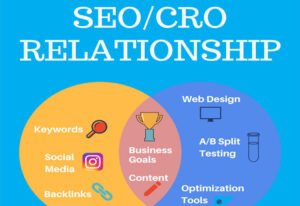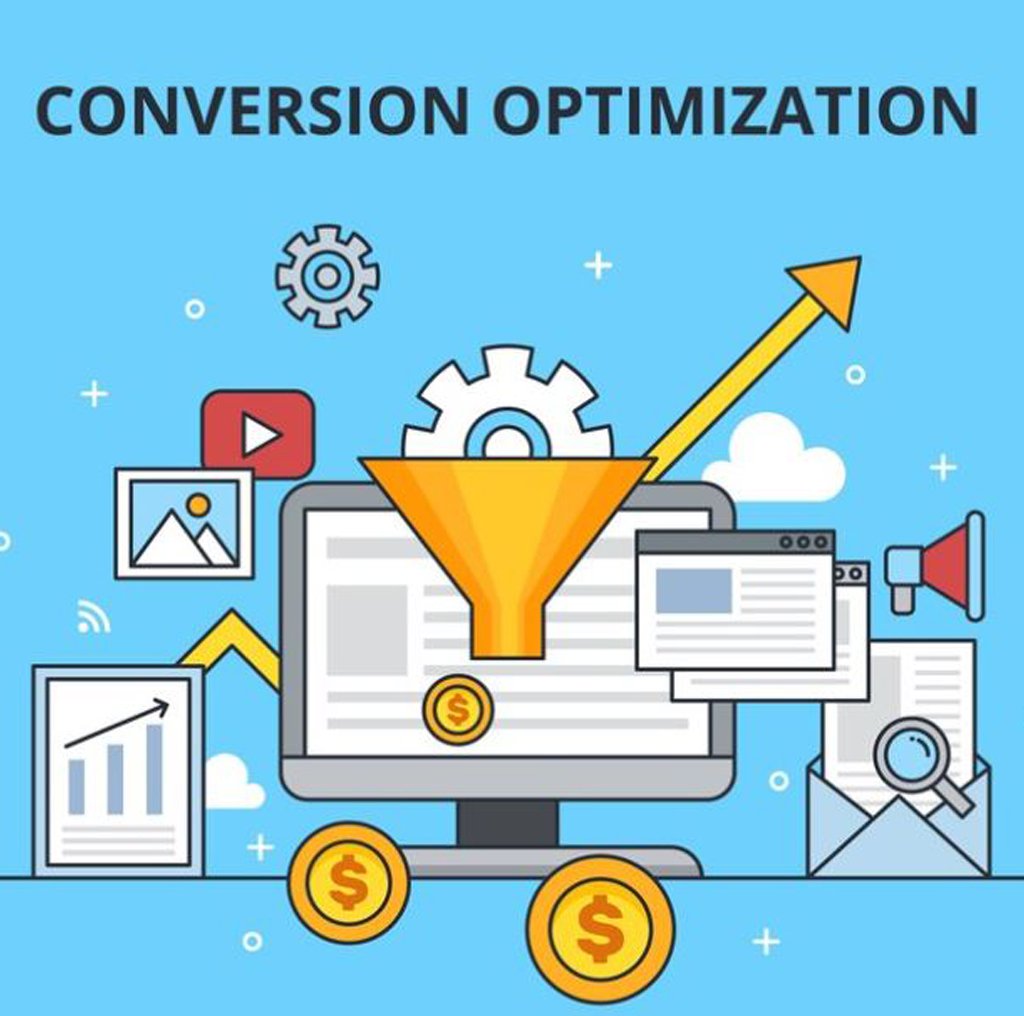The Relationship Between SEO and CRO
Search Engine Optimization (SEO) and Conversion Rate Optimization (CRO) are two critical components in the digital marketing ecosystem. While they serve different purposes, their relationship is intricate and symbiotic. SEO focuses on increasing the quantity and quality of traffic to a website through organic search engine results, while CRO is concerned with increasing the percentage of visitors who complete a desired action on the site, such as making a purchase or filling out a form.
Understanding the relationship between SEO and CRO is essential for any business looking to enhance its online presence and maximize its digital marketing efforts. This comprehensive exploration delves into how these two disciplines intersect, complement each other and contribute to overall digital marketing success.
SEO: An Overview
SEO involves a set of strategies aimed at improving a website’s visibility in search engine results pages (SERPs). These strategies are divided into three main categories: on-page SEO, off-page SEO, and technical SEO.
On-Page SEO
On-page SEO refers to the optimization of individual web pages to rank higher and earn more relevant traffic in search engines. Key components include:
- Keyword Research: Identifying the terms and phrases that potential customers are using to search for products or services.
- Content Quality: Creating high-quality, valuable content that satisfies user intent and answers their queries.
- Meta Tags: Optimizing title tags, meta descriptions, and header tags to improve click-through rates (CTR) and relevance.
- Internal Linking: Structuring internal links to enhance navigation and distribute page authority.
Off-Page SEO
Off-page SEO focuses on actions taken outside of your website to impact your rankings within SERPs. Key elements include:
- Backlinks: Acquiring high-quality backlinks from authoritative sites to improve domain authority and trustworthiness.
- Social Signals: Leveraging social media platforms to increase brand awareness and drive traffic.
- Brand Mentions: Encouraging mentions of your brand across the web to boost credibility.
Technical SEO
Technical SEO involves optimizing the technical aspects of a website to ensure it meets the requirements of search engines. Key aspects include:
- Site Speed: Ensuring fast load times to improve user experience and search rankings.
- Mobile-Friendliness: Optimizing for mobile devices to cater to the increasing number of mobile users.
- Crawlability: Ensuring search engines can easily crawl and index the site’s content.
- Structured Data: Using schema markup to help search engines understand the content and improve visibility.
CRO: An Overview
CRO focuses on increasing the percentage of website visitors who take a desired action, such as making a purchase, filling out a form, or signing up for a newsletter. It involves understanding user behavior, testing hypotheses, and implementing changes to improve the user experience and increase conversions.
Key Components of CRO
- User Experience (UX): Enhancing the overall user experience to make it easier for visitors to navigate the site and complete desired actions.
- A/B Testing: Running experiments with different versions of web pages to determine which performs better in terms of conversions.
- Landing Page Optimization: Designing and optimizing landing pages to maximize conversions from specific traffic sources.
- Call-to-Action (CTA): Crafting compelling CTAs that encourage visitors to take the desired action.
- Form Optimization: Simplifying and optimizing forms to reduce friction and increase submission rates.
- Trust Elements: Adding trust signals, such as testimonials, reviews, and security badges, to build credibility and encourage conversions.
The Intersection of SEO and CRO
The relationship between SEO and CRO is multifaceted. While SEO aims to attract visitors to a website, CRO seeks to convert those visitors into customers or leads. When both are executed effectively, they can significantly enhance a website’s performance and contribute to business growth.
Driving Relevant Traffic
SEO is primarily concerned with driving traffic to a website. However, the quality of this traffic is crucial for CRO. Attracting relevant visitors who are genuinely interested in the products or services offered increases the likelihood of conversions. Effective keyword research and content optimization ensure that the traffic generated through SEO is highly targeted and relevant.
Enhancing User Experience
User experience (UX) is a critical factor in both SEO and CRO. Search engines prioritize websites that offer a positive user experience, which includes fast load times, mobile-friendliness, and easy navigation. These elements also play a significant role in CRO, as a seamless and enjoyable user experience encourages visitors to stay on the site and complete desired actions.
Content Quality and Relevance
High-quality, relevant content is a cornerstone of both SEO and CRO. For SEO, content must be optimized to rank well in search engines and attract organic traffic. For CRO, the content must be engaging, informative, and persuasive to drive conversions. Creating content that meets the needs of users and aligns with their search intent is crucial for both disciplines.
Data-Driven Decision Making
Both SEO and CRO rely heavily on data and analytics to inform strategies and measure success. SEO professionals use tools like Google Analytics, Google Search Console, and various keyword research tools to track traffic, rankings, and user behavior. Similarly, CRO specialists use analytics to monitor conversion rates, user interactions, and the performance of different page elements. By leveraging data, businesses can make informed decisions to optimize both SEO and CRO efforts.
A/B Testing and Experimentation
A/B testing is a common practice in CRO to determine which variations of a web page perform better in terms of conversions. SEO can also benefit from A/B testing, particularly when it comes to optimizing meta tags, headlines, and content layouts. By experimenting with different elements and analyzing the results, businesses can identify the most effective strategies for both attracting traffic and converting visitors.
Synergistic Strategies for SEO and CRO
To maximize the benefits of SEO and CRO, businesses should adopt a holistic approach that integrates both disciplines. Here are some strategies that can enhance the synergy between SEO and CRO:
Keyword Optimization for User Intent
Understanding user intent is crucial for both SEO and CRO. By conducting thorough keyword research and analyzing search intent, businesses can create content that not only ranks well in search engines but also meets the needs of users. This approach ensures that the traffic generated through SEO is more likely to convert, as the content aligns with what users are searching for.
Optimized Landing Pages
Landing pages play a pivotal role in both SEO and CRO. For SEO, optimized landing pages with targeted keywords can improve search rankings and attract organic traffic. For CRO, these pages must be designed to maximize conversions by providing relevant information, persuasive CTAs, and a seamless user experience. Integrating SEO and CRO principles in landing page design can lead to higher conversion rates and improved search visibility.
Mobile Optimization
With the increasing number of mobile users, mobile optimization is essential for both SEO and CRO. Search engines prioritize mobile-friendly websites in their rankings, and users expect a smooth browsing experience on their mobile devices. Ensuring that websites are responsive and optimized for mobile can improve search rankings, enhance user experience, and increase conversion rates.
Content Marketing
Content marketing is a powerful strategy that supports both SEO and CRO. High-quality, informative content can attract organic traffic, build trust, and engage users. By creating content that addresses user pain points, answers their questions, and provides valuable insights, businesses can drive traffic and encourage conversions. Incorporating SEO best practices, such as keyword optimization and internal linking, can further enhance the effectiveness of content marketing efforts.
Page Speed Optimization
Page speed is a critical factor for both SEO and CRO. Search engines favor fast-loading websites, and users are more likely to stay on a site that loads quickly. Slow load times can lead to higher bounce rates and lower conversion rates. By optimizing page speed, businesses can improve search rankings, enhance user experience, and increase the likelihood of conversions.
Clear and Compelling CTAs
Call-to-action (CTA) elements are essential for driving conversions. Clear, compelling CTAs can guide users toward completing desired actions, such as making a purchase or signing up for a newsletter. Optimizing CTAs for both SEO and CRO involves using relevant keywords, ensuring visibility, and making them actionable. A/B testing different CTAs can help identify the most effective variations.
Trust and Credibility
Building trust and credibility is vital for both SEO and CRO. Search engines consider factors like domain authority and backlinks when ranking websites, while users look for trust signals such as reviews, testimonials, and security badges. By enhancing trust and credibility, businesses can improve search rankings and increase conversion rates. Incorporating trust elements into website design and content can reinforce credibility and encourage users to take action.
Common Challenges and How to Overcome Them
While SEO and CRO are complementary, there are challenges that businesses may face when trying to integrate both disciplines. Understanding these challenges and implementing strategies to overcome them can lead to more effective digital marketing efforts.
Balancing SEO and CRO Priorities
One common challenge is balancing the priorities of SEO and CRO. SEO efforts may focus on driving traffic, while CRO aims to convert that traffic into customers. It’s essential to strike a balance between attracting visitors and providing a user experience that encourages conversions. This can be achieved by aligning SEO and CRO goals and ensuring that both teams collaborate closely.
Avoiding Conflicting Strategies
At times, SEO and CRO strategies may conflict. For example, adding too many keywords for SEO purposes can result in content that feels unnatural and detracts from the user experience. Conversely, optimizing solely for CRO may neglect important SEO elements. To avoid conflicts, businesses should adopt an integrated approach that considers the needs of both disciplines and finds a middle ground.
Measuring Success
Measuring the success of integrated SEO and CRO efforts can be challenging. While SEO success is often measured by metrics such as organic traffic, rankings, and backlinks, CRO success is measured by conversion rates, average order value, and customer retention. To gain a comprehensive understanding of performance, businesses should track and analyze a combination of these metrics, using tools like Google Analytics and conversion tracking software.
Keeping Up with Algorithm Changes
Search engine algorithms are constantly evolving, which can impact both SEO and CRO strategies. Staying updated with the latest algorithm changes and industry trends is crucial for maintaining and improving performance. Businesses should invest in continuous learning, subscribe to industry publications, and participate in relevant webinars and conferences to stay informed.
Case Studies: Success Stories of Integrated SEO and CRO
Examining real-world examples of businesses that have successfully integrated SEO and CRO can provide valuable insights and inspiration. Here are a few case studies that highlight the benefits of combining these two disciplines.
Case Study 1: E-Commerce Website
An e-commerce website specializing in fashion products implemented an integrated SEO and CRO strategy to boost online sales. The approach included:
- Conducting keyword research to identify high-intent search terms and optimizing product pages accordingly.
- Creating high-quality, informative blog content that addressed common customer queries and incorporated relevant keywords.
- Improving page load times and ensuring the site was mobile-friendly.
- A/B testing different versions of product pages and CTAs to identify the most effective variations.
- Adding trust signals such as customer reviews, security badges, and money-back guarantees to build credibility.
The results were impressive. Organic traffic increased by 40%, and the conversion rate improved by 25%, leading to a significant boost in online sales.
Case Study 2: SaaS Company
A Software as a Service (SaaS) company sought to improve lead generation through an integrated SEO and CRO strategy. Key initiatives included:
- Optimizing landing pages with targeted keywords and relevant content to improve search rankings.
- Implementing A/B testing on landing pages to identify the best-performing designs and CTAs.
- Enhancing user experience by simplifying navigation and reducing form fields on lead capture forms.
- Creating in-depth, valuable content that addressed the pain points of their target audience and incorporated SEO best practices.
As a result, the company experienced a 50% increase in organic traffic and a 30% improvement in lead conversion rates, significantly boosting their lead generation efforts.
Case Study 3: Financial Services Firm
A financial services firm aimed to attract more clients and increase online inquiries through an integrated SEO and CRO strategy. Key actions included:
- Conducting comprehensive keyword research to identify relevant search terms and optimizing service pages accordingly.
- Creating high-quality blog content that addressed common financial concerns and incorporated targeted keywords.
- Optimizing site speed and ensuring the website was mobile-friendly.
- Implementing A/B testing on inquiry forms and CTAs to identify the most effective variations.
- Adding trust signals such as client testimonials, case studies, and industry certifications to build credibility.
The integrated approach led to a 35% increase in organic traffic and a 20% improvement in online inquiries, helping the firm attract more clients and grow its business.
The relationship between SEO and CRO is integral to digital marketing success. While SEO focuses on attracting visitors to a website, CRO aims to convert those visitors into customers or leads. By understanding and leveraging the synergy between these two disciplines, businesses can enhance their online presence, drive relevant traffic, and increase conversions.
An integrated approach that balances the priorities of both SEO and CRO, incorporates data-driven decision-making and focuses on user experience can significantly improve overall performance. By adopting best practices and overcoming common challenges, businesses can achieve their digital marketing goals and drive sustainable growth.
Final Thoughts
The importance of SEO and CRO cannot be overstated in the ever-evolving digital landscape. As search engines continue to refine their algorithms and user expectations evolve, businesses must stay agile and adapt their strategies to remain competitive. By investing in continuous learning, leveraging data and analytics, and maintaining a user-centric approach, companies can create a strong foundation for long-term success in the digital marketplace.
Ultimately, the relationship between SEO and CRO is about more than just driving traffic and increasing conversions. It’s about creating a holistic digital marketing strategy that aligns with business goals, meets the needs of users, and delivers measurable results. By understanding and harnessing the power of SEO and CRO, businesses can unlock new opportunities, achieve their objectives, and thrive in the dynamic world of digital marketing.


